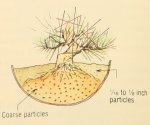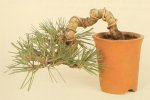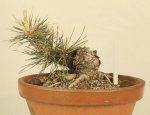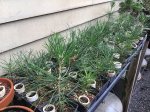This is a very interesting question - why cut the stems so short? In BT #20, Mr. Matsuo advises:
View attachment 115211
The purpose, I believe, is to get needle buds and the first nodal junction (containing all the adventitious buds) close to the soil level. I do not believe that this is to have branches right at the soil level, but to give some options for trunk development - he wants to create movement and taper right from the nebari, not starting halfway up the trunk in a Shohin tree. Look at this figure he publishes later in his article (please please please don't comment on the soil instructions):
View attachment 115214
To create this image, one has to first grow a sacrifice branch vertically to thicken the nebari and first trunk section. Then one must cut back to a low branch to develop a new leader for the next trunk section. Like this:
View attachment 115215
That creates movement and taper right from the soil level and all the way up the tree. There are no branches at the first node - it's another section of trunk. If you don't do this, your taper will start well up the trunk. You can create movement with wire, but the lower section will be without taper. It'll end up like this:
View attachment 115221
Not a bad tree, to be sure. There is interesting movement on the trunk, but no taper all the way up to the branches.
Study this figure (I love the cigarette for scale - I think because it hasn't been smoked it's still PC).
View attachment 115216
In this case, he's creating a semi-cascade. The first node is the big bend in the trunk - he's allowed a sacrifice branch to grow long to thicken the first basal section and then cut all the way back to the first node to begin training a low branch into a cascading leader. Here's a top view of the same plant:
View attachment 115218
Study this figure carefully, because it clearly tells the story. You can clearly see where the sacrifice branches have been eliminated. At each cut back there is both movement and taper that have been created in the trunk line.
Anyway, I strongly encourage anyone interested in this method to beg/borrow/steal BT #20 and read this article. There is also a companion piece describing a modification of this method used to create cascade bonsai as well and some really spectacular trees that Mr. Matsuo created. I'm guessing it will take about ten years to finished tree - interestingly, about the same amount of time it takes to start with a flawed tree and fix it.
Scott






